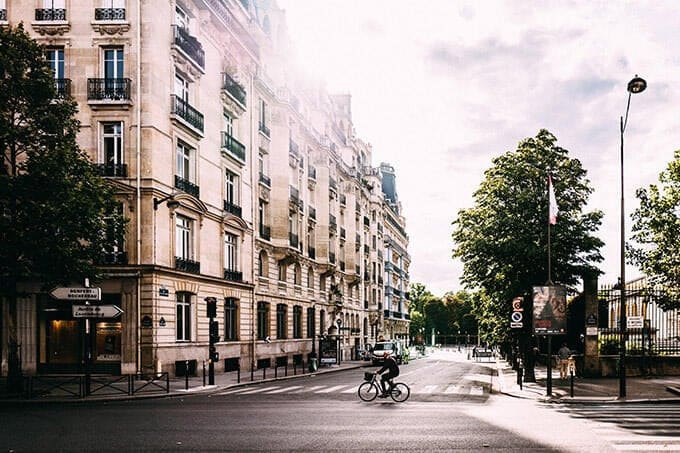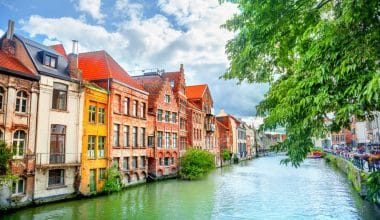Paris is one of the most popular tourist destinations in Europe, attracting over 30 million visitors annually. There’s a good explanation for this, though. For starters, Paris is home to some of the best museums in the world as well as stunning buildings, chic boutiques, and delectable restaurants. But, it can be difficult for a first-time visitor to Paris to figure out where to stay. It would be impossible to walk everywhere in the French capital. So this article will provide you with a comprehensive guide to the best places to stay in Paris if you are visiting for the first time.
Let’s get the ball rolling…
Things to Consider Before Booking a Hotel in Paris
Stay in the Single-Digits Arrondissement
It is generally recommended that first-time visitors stay in the single digits arrondissements. These are the most central, easy to get around, well-connected, and generally safe neighbourhoods.
By looking at the address, you can quickly determine which arrondissement your hotel is in. The last two digits of the postal code 75001, for example, refer to the number of the arrondissement in “218 rue de Rivoli, 75001 Paris.” The smaller the digit, the more central the area.
Close Proximity to Public Transportation
Regardless of which arrondissement you choose, stay within a short walk of a metro station. It will save you a lot of time walking because even if you stay right next to the Louvre, you will still need to take the metro to some of the attractions.
Avoid staying in areas near train stations, particularly Gare du Nord (no matter how convenient it appears). The area surrounding Gare du Nord is unpleasant and unsafe.
Room Size
Hotel rooms in Paris are generally small (even if you book a suite) and expensive. Bathrooms are even more cramped. As a result, plan ahead of time and have realistic expectations.
What Are the Best Areas to Stay in Paris for First-Time Visitors?
The following arrondissements (districts) in Paris are the best options for first-time visitors: Louvre, Eiffel Tower, Champs-Elysées, La Marais, and Saint-Germain-des-Près.
You can also stay in Montmartre, Montparnasse, or the Latin Quarter.
Those looking for a fun night out after a day of sightseeing should stay in Bastille, South Pigalle, or Oberkampf.
In any case, staying as close to a metro station as possible will greatly benefit your first trip to Paris.
In the following sections, we will delve deeper into each recommended arrondissement.
What are Arrondissements?
Paris is divided into twenty arrondissements, which are essentially districts.
The main road, Boulevard Périphérique, surrounds all twenty districts.
The 1st arrondissement is located in the heart of the city, and the further you get from the boulevard, the higher the number of the arrondissement.
The majority of Paris’s major attractions are concentrated in the lower-numbered arrondissements.
The Best Areas to Stay in Paris for First-Time Visitors Are
Louvre (1st Arrondissement)
When visiting Paris for the first time, the majority of visitors’ primary goal is to go sightseeing.
There are a few good centrally located areas in Paris, one of which is the 1st arrondissement, which contains the Louvre.
This area, which is one of Paris’s oldest, has a high price tag, so staying here is not recommended if you’re on a tight budget.
One of the advantages of staying in the 1st Arrondissement is that you have easy access to all major metro lines.
From here, you can get to every major attraction as quickly as possible.
However, many of them are within walking distance and can be reached by simply crossing one of the major bridges.
Read Also: Where to Stay in Paris: 17+ Top Locations in 2023
If your budget allows it, the 1st Arrondissement – also known as “The Louvre” – is the best neighbourhood to stay in for first-time visitors to Paris.
The majority of the major attractions are walkable, and the few exceptions can be reached by metro.
The 7th arrondissement, which we recommend in the following paragraph, is frequently listed as the best area to stay in Paris for first-time visitors, but it is far from experiencing a lively evening.
La Marais (3rd and 4th Arrondissement) is one of Paris’ most vibrant nightlife districts, and it is connected to the Louvre.
So, staying in this area allows you to move around easily and enjoy Paris in the evenings to the fullest while having major attractions practically at your doorstep.
Eiffel Tower (7th Arrondissement)
The 7th arrondissement is the most popular tourist district in Paris, with direct access to the Eiffel Tower, the Hôtel des Invalides, and other major attractions.
There are four metro lines that run through this area, namely Line 8, Line 10, Line 12, and Line 13, which allow you to easily visit other attractions such as the Sacré-Coeur. Line 10 will get you to the Notre Dame, Pantheon, and Sainte-Chapelle in no time.
When you book a hotel in this area of Paris, you often get a beautiful panoramic view of the city with the Eiffel Tower in the background.
Surprisingly, this area is actually quiet in the evening, with no nightlife to be found.
The reason for this is that there aren’t as many residents here as in other areas.
Because of this, and the fact that some of the most luxurious hotels are located in this area, the 7th Arrondissement is not only a great place to stay in Paris for first-time visitors but also for couples because you won’t be bothered in the evening.
During the day, this bustling neighbourhood is home to a variety of exciting shops, restaurants, and bakeries.
Walking around the area is an attraction in and of itself. Hotels are not cheap, as you might expect when staying in the city’s heart.
Champs-Elysees (8th Arrondissement)
The 8th arrondissement is located on the opposite side of the Seine River from the previous 7th arrondissement.
The Champs-Elysées, Paris’ most famous boulevard, runs right through the heart of this district, housing all of the top fashion brands’ stores as well as the Arche de Triomphe.
These high-end fashion brands attract wealthy tourists from all over the world, and the hotels in this area are accordingly upscale.
If you stay near the river, a simple crossing via one of the bridges will take you to the 7th arrondissement, where the Eiffel Tower can be found.
The Louvre and other major attractions can be reached by taking the Line 1 metro. The 8th arrondissement is much more vibrant than the previous two recommended areas, with a wide range of exciting restaurants.
La Marais (3rd and 4th Arrondissement)
Because the fourth arrondissement is small and includes two islands, the third and fourth arrondissements are frequently combined.
This so-called La Marais is one of the most exciting areas in Paris because it is centrally located and has access to many good restaurants and unique shops, but it is also bustling in the evening, unlike the first two recommended areas.
In fact, La Marais is one of Paris’ three major nightlife districts, and it is particularly well-known among the LGBT community. You’re close to Notre Dame, the Pantheon, and the Louvre.
Except for the Arche de Triomphe, you have access to the metro. However, these are not the lines that take you to the attractions located a bit outside the tourist centre.
All of the other attractions require you to change lines near the nearby Louvre.
La Marais is one of Paris’s busiest neighbourhoods, and it’s especially exciting for those who want to explore the city at night. La Marais, like the majority of the recommended areas in this article, is a safe area.
The further you travel from the city centre, the more dangerous Paris becomes.
Montmartre (18th Arrondissement)
As stated at the start of this article, the greater the number of arrondissements, the greater the distance from the capital’s epicentre.
You’d think the 18th Arrondissement is far from the main attractions, but it’s actually the district where you’ll find the Sacré-Coeur.
This district is a typical residential area where you can observe Parisians going about their daily lives.
The picturesque Rue des Martyrs, a street filled with unique shops and art galleries, is a must-see.
Many famous painters, including Picasso, lived in Montemarte. Walking through this area of Paris gives you a romantic feeling with scenery that you only see in Hollywood movies.
There are several metro lines that will take you to the tourist arrondissements.
This is necessary because the main attractions are not within walking distance.
Keep in mind that the 18th arrondissement is close to the Gare du Nord, Paris’ main train station.
In the evening, the area becomes sketchy, and walking there in the dark does not feel safe. However, Montmartre is a completely safe neighbourhood.
Saint-Germain-dès-Près (6th Arrondissement)
Aside from the twenty arrondissements, Paris is also divided into two sections: the left bank and the right bank.
This may appear more complicated than it is, as the left bank contains the Eiffel Tower and the right bank contains the Sacré-Cur. The left bank, which includes the 6th arrondissement of Saint-Germain-des-Près, is known for its classical architecture, main attractions, and the fact that it’s a great place to walk around.
Staying in this district provides you with direct access to the Jardin du Luxembourg, which is ideal for a morning stroll.
The Pantheon, Notre Dame, and the Sainte-Chapelle are all nearby attractions, but only the Luxembourg Garden is located within the 6th arrondissement.
There are three different metro lines that run through this area, so getting around is a breeze.
In the evening, Saint-Germain-des-Près is quiet. We recommend crossing the bridge to the popular nightlife district of Le Marais. Apart from its central location, Saint-Germain-des-Près has beautiful architecture.
Belleville (20th arrondissement)
Belleville is located in the 20th arrondissement, which means it is far from the tourist hotspots of Paris.
However, this trendy neighbourhood has a few distinguishing features that others cannot match. It’s a vibrant neighbourhood teeming with working-class people from all over the world.
Unique and reasonably priced restaurants can be found here. This means you can also find cheap hotels here.
One of Belleville’s unique features is the Pere Lachaise Cemetery, which is home to some of the world’s most famous people, including Jim Morrison, Oscar Wilde, Edith Piaf, and Frederic Chopin.
Belleville is an excellent choice if you want to experience Paris from the perspective of a Parisian and see how ordinary people live.
There are two metro lines in the 20th arrondissement that take you directly to the Louvre. Your sightseeing adventure begins here.
Montparnasse (14th Arrondissement)
Montparnasse, the 14th arrondissement, is located south of the city centre, directly beneath the 6th.
This area is popular among students because it is home to several universities. This part, like many student areas in European cities, is more affordable, and you can observe the daily lives of young Parisians in a mostly residential area.
There are no major attractions nearby that are easily accessible by foot; however, near the Catacombs, there are three different metro lines that will take you to the city’s highlights.
You’ll find cheaper lodging in Montparnasse, and the area is buzzing thanks to the younger generation.
The compromise you make is that you must travel a short distance by metro to reach the tourist attractions. In exchange, you will encounter a local vibe that you will not find in the main tourist areas.
Latin Quarter (5th Arrondissement)
The Latin Quarter is situated to the east of Saint-Germain-des-Près. Whereas the previously recommended areas for first-time visitors in Paris were touristy, the Latin Quarter is a less-touristy alternative that retains the iconic atmosphere of Paris.
Some of Paris’ universities can be found here, and during the day, many students can be found in one of the many bookstores and nice little cafes, though most students stay at Montparnasse.
Shakespeare & Company, one of the most famous bookstores in Paris, is located in this area, adding romance to the area.
Staying in the Latin Quarter is especially recommended if you’re travelling as a couple.
It’s one of Paris’s oldest neighbourhoods, and walking through its narrow, cobblestone streets feels like stepping back in time.
For food, visit the famous Rue Mouffetard, which features an extraordinary outdoor food market.
There are some major attractions nearby, but your best bet is to use one of the city’s excellent public transportation systems to get around.
Bastille
Bastille is a lively neighbourhood on Paris’s east side that is popular with young people.
It was the site of the infamous storming of the prison during the French Revolution.
Nowadays, it’s best known for its vibrant nightlife, which includes a wide variety of bars, clubs, and music venues.
This area has something for everyone, whether you like jazz, electronic music, or live performances.
Many cultural attractions can also be found in Bastille, such as the Opéra Bastille, which hosts a variety of operas and ballets throughout the year.
Read Also: BEST SMALL BUSINESS BANK ACCOUNT: Top 13+ Options In 2023 (+ No Fees Picks)
The nearby Musée des Arts et Métiers, which features exhibits on the history of science and technology, is also worth a visit.
The Marché d’Aligre, the area’s famous open-air market, is a great place to find fresh produce, cheese, and other regional specialities.
With multiple metro lines and bus routes running through the area, Bastille is well-connected to the rest of Paris.
You’ll be at Paris Gare de Lyon, a large train station with a connection to the GTV, in a matter of minutes.
It’s also close to the Seine River and other popular attractions like the Marais and the Jardin des Plantes.
You’re not in the heart of everything, but that’s nearly impossible unless you’re willing to pay a premium for a hotel room.
As a result, Bastille is a bit more affordable, with a fantastic nightlife scene.
We believe that staying at Bastille would be especially enjoyable for younger travellers.
South Pigalle
South Pigalle (also known as So-Pi) is located directly beneath Montmartre and contains the aforementioned, picturesque Rue des Martyrs.
While most tourists prefer to stay in Montmartre, South Pigalle has grown in popularity in recent years.
It is known for its trendy atmosphere, with many boutique shops, cafes, and restaurants catering to a hip and youthful crowd.
The neighbourhood has a vibrant nightlife scene, with numerous bars and clubs that stay open late.
There are several other cultural highlights in this area, including the Musée de la Vie Romantique, which exhibits Romantic art and artefacts.
The nearby Palais Garnier, with its opulent interiors and world-class opera performances, is also worth a visit.
Other popular areas nearby include Montmartre, Pigalle, and the Grands Boulevards.
The famous Moulin Rouge is also just around the corner.
While Montmartre is undoubtedly more romantic, South Pigalle is in a better location and has a more vibrant nightlife.
Oberkampf
Oberkampf, like Bastille, is located in the large 11th district, west of Belleville.
It has one of the city’s best nightlife scenes.
It also has some of the best street art in Paris, with numerous murals and graffiti pieces reflecting the neighbourhood’s bohemian and artistic vibe.
There are no major city highlights in this area, but there are numerous metro lines that will take you there.
If you want to fully experience Paris’ nightlife scene, you should definitely stay in this area.
However, there are definitely better options for sightseeing in the city.
What is the cheapest month to stay in Paris?
The months of April through June and October through early November are ideal for a trip to Paris because the weather is mild during those months and there are fewer tourists in the city. However, the beginning of December, January, and February are the least expensive months to visit Paris because these are considered off-season months due to the harsh winters that Paris experiences.
How many nights in Paris is enough?
Plan to spend at least three full days in Paris in order to get a good feel for the city, see some of the city’s most famous landmarks, and discover its most famous neighborhoods. However, if you want to have a good time and relax, I think that spending seven days in Paris is a good place to begin, especially if it is a place that you have been fantasizing about going to for a long time.
Related Articles
- CHEAPEST STATES TO BUY A HOUSE
- Luxury Bag Brands: Top 2023 Luxury Handbag Brands List (Updated)
- Most Profitable Niches For Your New Online Business






